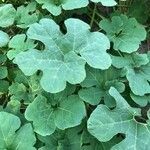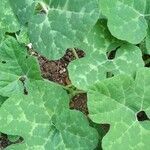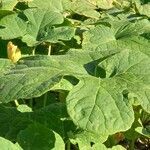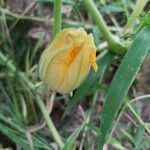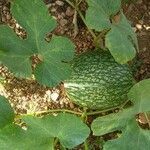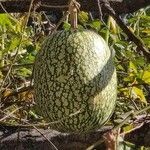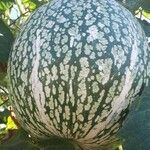Plants annual or short-lived perennial; roots taproots. Stems prostrate or climbing, often rooting adventitiously at nodes, to 25 m, usually sparsely hirsute with puberulent understory of gland-tipped hairs, sometimes without hirsute overstory, without pustulate-based hairs; tendrils 3–4-branched 3–5 cm above base, glabrous, eglandular. Leaves: petiole 8–20 cm, sparsely hirsute to hispid-hirsute, without pustulate-based hairs; blade <sometimes mottled with silvery green>, suborbiculate to ovate or reniform, palmately 3–5-lobed, 11–16 × 15–26 cm, usually broader than long or equally so, base cordate, sometimes shallowly and irregularly toothed, lobes <with sinuses shallow or ± 1/2 to petiole>, obovate to ovate, depressed-ovate, or triangular, midveins of leaf lobes not distinctly elongate-whitened, margins closely mucronulate to denticulate, surfaces short-villous to pubescent, eglandular. Peduncles in fruit 5-ribbed, slightly or not expanded at point of fruit attachment, hardened, woody. Flowers: hypanthium campanulate, 5–10 mm; sepals linear-lanceolate, <not foliaceous>, 5–15 mm; corolla yellow to yellow-orange, tubular-campanulate, 6–12 cm (staminate at shorter end of range); anther filaments sparsely short-villous, hairs viscid-glandular; ovary densely pubescent. Pepos (1) light or dark green, with or without longitudinal white lines or stripes distally, (2) irregularly, often linearly mottled, green and white, or (3) whitish to cream, globose to broadly ovoid or ovoid-elliptic, (15–)20–50 cm, smooth, <flesh usually white, sweet>. Seeds usually dark brown to black, sometimes whitish, ovate to ovate-elliptic or oblong-elliptic, 15–25 mm, margins raised-thickened and smooth, surfaces smooth. 2n = 40.
More
Annual or short-lived hairy perennial, with long-running or trailing ± scabrid stems bearing branched tendrils. Petioles scabrid, hollow, to c. 20 cm long. Lamina to c. 18 × 20 cm (larger in cultivation), broad-ovate, 5-7-lobed, densely puberulent especially beneath, with longer scabrid hairs on both sides; sinuses between lobes narrow and deep, rounded at the bottom; margins ± denticulate; base very broadly cordate with wide sinus. Peduncles of ? fls puberulent, to at least 25 cm long; peduncles of ? fls ± expanded at apex at fruiting. Calyx 17-25 mm long, lobed 1/2-⅔; lobes linear-subulate, puberulent and with scattered longer hairs. Corolla 7-10 cm long, hairy on both sides; lobes 3-5 cm long, involute, with apical green mucro. Anther mass c. 1.5-2 cm long. Perianth of ♀ fls similar to ♂, but somewhat larger. Fr. usually 15-25-(30) × 13-22 cm, broadly oblong-ellipsoid; rind mottled green and white, hard and shell-like, smooth; pulp white; stalks thick but not expanded at apex. Seed ellipsoid, very dark brown or black; margin obtuse, not raised.
A pumpkin family plant. It is a creeping or climbing plant. It is a vine which grows to several metres long. It grows as an annual. It does not have swollen reserve roots. The plant is softly hairy. It has 5 vigorous angular stems. The leaf stalks are 5-25 cm long. The leaves are oval or heart shaped. They may or may not have white spots on the surface. The leaves have 3-5 rounded lobes. The central one is larger than the side ones. The tendrils are divided 3-4 times. The flowers occur singly in the axils of leaves. Flowers are yellow to orange. The male flowers have longer stalks. The fruit are large, bright green and mottled. The fruit contain white flesh and black seeds. The seeds are 15-25 mm long by 7-12 mm wide.
It suits high altitudes. It can tolerate low temperatures but not frosts. It grows between 1,000 and 3,000 m altitude in South America. In the Philippines it grows above 1,700 m above sea level. It needs soil temperatures above 15°C for seeds to germinate. It suits hardiness zones 8-11.
